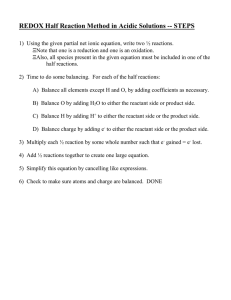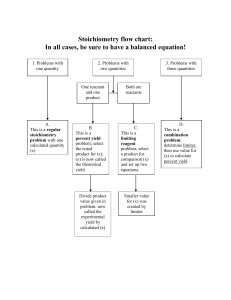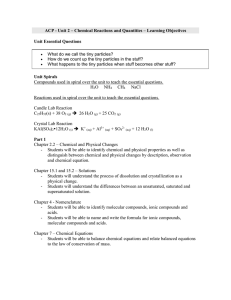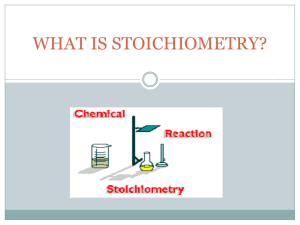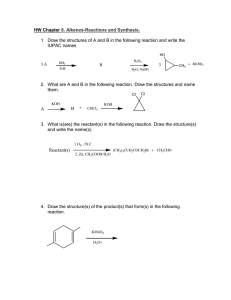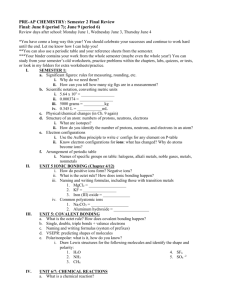Chemical Reactions
advertisement
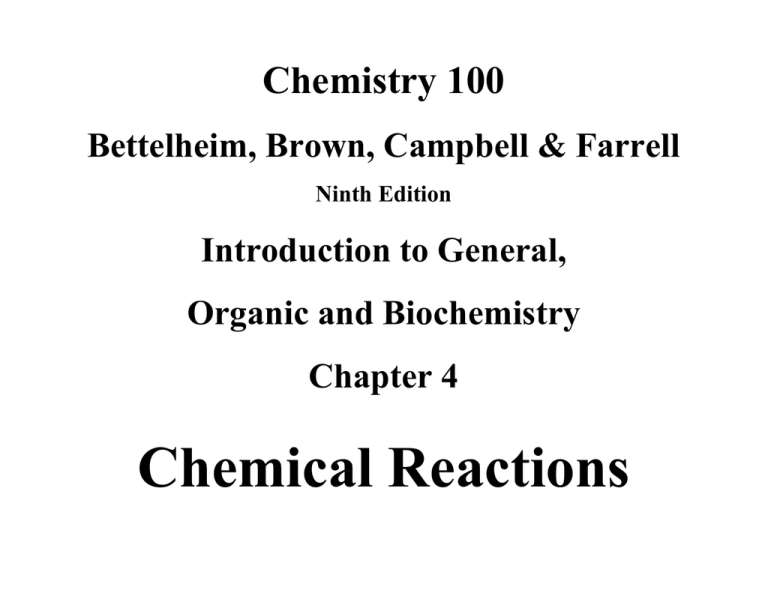
Chemistry 100 Bettelheim, Brown, Campbell & Farrell Ninth Edition Introduction to General, Organic and Biochemistry Chapter 4 Chemical Reactions Chemical Reactions In a chemical reaction, one set of chemical substances called reactants are converted to another set of substances called products. The atoms comprising reactants are rearranged to form products, but no atoms are created or destroyed. In this chapter we discuss three aspects of chemical reactions: 1) Mass relationships (stoichiometry). 2) Types of reactions. 3) Heat (energy) gain or loss resulting from reactions. Formula Weight and the Mole The Formula Weight of a substance is the total weight of all the atoms comprising the chemical formula of that substance. FWt. = ? For C6H6 FW = 6(At. Wt. C) + 6(At. Wt. H) FWt. = 6(12.011) + 6(1.008) = 78.114 amu If the substance is a covalent molecule the FWt. is called a Molecular Weight. If the FWt. is expressed in grams/mole it is called a Molar Mass. One molar mass of any substance contains one Avogadro’s Number of units = 6.02214199 x 1023units. Formula Weight and the Mole One Mole is defined as the number of atoms contained in exactly 12 grams of carbon-12. One Mole of any substance contains exactly this same number, Avogadro’s Number, of formula units. Moles reacted have an exact 1:1 relationship to the coefficients found in a balanced chemical equation of formula units. We now have a relationship between the formula units in a chemical equation and something we can measure on a chemical balance, i.e. grams. This is called stoichiometry. Molar Mass and Reacting Weights If we have a balanced chemical equation we can now compute the grams of one substance that will react with another: How much hydrogen and oxygen must react to produce 65.00 grams of water? Balanced Eqn: Stoichiometry: 2 H2 + O2 1 mole 2 moles 2 H2O 2 moles Stoichiometry Using the equality: 1 mole = xxxx grams We can create a conversion factor that will convert any mass to moles for a given molar mass. We can create a conversion factor that will convert any number of moles of a substance to a mass that can be weighed. Using the equality: 1 mole = 6.02214199 x 1023 units We can convert any number of moles into the number of formula units it contains. We can then determine from the formula for the substance how many atoms of each element it contains. Balancing Chemical Equations When one has an equation in words such as; butane + oxygen yields carbon dioxide + water We must write the chemical equation: C4H10(g) + O2(g) Æ CO2(g) + H2O(g) This equation tells us the substances, their composition and physical state. But it doesn’t tell us how much of each reacts. The equation must be balanced! First: Start with an element that occurs in only one substance on each side of the equation. If more than one choose the one nearest the center of its period in the Periodic Chart. This case choose carbon: C Balancing Chemical Equations C4H10(g) + O2(g) Æ 4 CO2(g) + H2O(g) Now choose the other element bound to carbon: C4H10(g) + O2(g) Æ 4 CO2(g) + 5 H2O(g) Now balance the oxygens, by adjusting O2(g) C4H10(g) + 6.5 O2(g) Æ 4 CO2(g) + 5 H2O(g) Make all coefficients whole numbers: multiply Eqn. by 2. 2 C4H10(g) + 13 O2(g) Æ 8 CO2(g) + 10 H2O(g) It is now possible to calculate the reacting masses of the substances in the chemical equation. Limiting Reactant Chemists rarely react exactly the reacting masses required in a balanced chemical equation. For many reasons it it common to have more of one substance than the equation requires. This reactant is in excess and not all of it will react. But this one is not as important as the lesser reactant. The reaction stops when the lesser reactant is used up! This reactant is called the Limiting Reactant! The amount of the limiting reactant determines the actual amounts of the substances that react! Limiting Reactant If we have a balanced chemical equation and for whatever reason have an excess of oxygen, we can still compute the grams of one substance that will react with another: How much hydrogen must react with unlimited oxygen to produce 65.00 grams of water? Limiting Reactant In a chemical equation theoretically any reactant may be the Limiting Reactant. In practice, however, chemists are usually limited by other constraints. For example: Butane burns cleanly to carbon dioxide and water in excess oxygen. But if butane is in excess the reaction is not clean and carbon monoxide (a poison!), and carbon (soot!) will form along with some carbon dioxide and water. In reality, chemistry, and chemists, must allow for these vagaries of nature! Limiting Reactant and Theoretical Yield When a chemist reacts two or more reactants, one of which is the limiting reactant, the maximum yield possible, the theoretical yield, may be calculated. Rarely does a reaction, or a chemist, actually produce this amount of material in purified form. This lesser amount is called the actual yield. The Percent Yield is the percent of the theoretical yield this actual yield represents. It represents the efficiency of the reaction together with the prowess of the chemist. actual yield (100) = percent yield theoretical yield Reactions Between Ionic Compounds Ionic compounds or salts consist of both positive and negative ions. When an ionic compound dissolves in water, it dissociates to aqueous ions. KCl(s) H2O K+(aq) + Cl-(aq) When aqueous solutions of two different ionic compounds or salts are mixed, the ions intermingle. If two of the ions combine to form a water-insoluble compound, a precipitate will form, a reaction has occurred. If this doesn’t happen, no physical change will be observed. spectator ions K+(aq) Ag+(aq) + + Cl -(aq) NO 3-(aq) K+(aq) + NO 3-(aq) + AgCl (s) a precipitate Reactions Between Ionic Compounds The equation that expresses only the reaction that occurs is called the net ionic equation. Ag+(aq) + Cl-(aq) AgCl(s) net ionic equation = all spectator ions omitted Reactions Between Ionic Compounds In general, ions in solution react with each other when one of the following has happened: Two ions form a compound that is insoluble in water. Two ions react to form a gas that escapes from the reaction mixture as bubbles. H+(aq) + HCO3-(aq) CO2(g) + H2O the gas formed excapes from the solution An acid neutralizes a base (Chapter 8) H +(aq) + OH -(aq) H 2O One of the ions can oxidize another (Section 4.7) Oxidation – Reduction Reactions Oxidation: the loss of electrons by a species. Reduction: the gain of electrons by a species. Oxidation-reduction (redox) reaction: any reaction in which electrons are transferred from one species to another. An alternative definition of an oxidation-reduction reaction is: Oxidation: the gain of oxygen or loss of hydrogen by a species. Reduction: the loss of oxygen or gain of hydrogen by a species. Oxidation – Reduction Reactions Oxidation-reduction (redox) reaction: any reaction in which electrons are transferred from one species to another: a gain of two electrons Cu2+(aq) + Zn2+(aq) + Zn(s) Cu(s) a loss of two electrons What is observed is the blue copper solution gradually fades to colorless and the zinc diminishes and what remains gets copper plated. Using the Alternative RedOx Definition: CH4(g) + 2 O2(g) Æ CO2(g) + 2 H2O(g) Carbon oxidized Oxygen Reduced Heats of Reaction In almost all chemical reactions, heat is either given off or absorbed: Exothermic reaction: one that gives off heat Endothermic reaction: one that absorbs heat Heat of reaction: the heat given off or absorbed in a chemical reaction For example: The combustion (oxidation) of carbon liberates 94.0 kcal per mole of carbon oxidized. C(s) + O2(g) Æ CO2(g) + 94.0 kcal/mole C Heat of combustion: the heat given off in a combustion reaction; all combustion reactions are exothermic.
